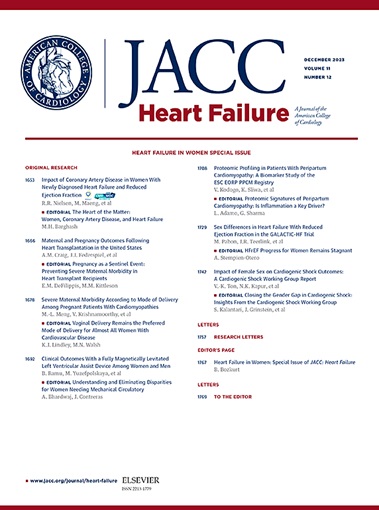心脏移植前持久左心室辅助装置支持患者的原发性移植物功能障碍。
IF 11.8
1区 医学
Q1 CARDIAC & CARDIOVASCULAR SYSTEMS
引用次数: 0
摘要
先前的单中心研究发现移植前持久左心室辅助装置(LVAD)支持与心脏移植(HT)后严重的原发性移植物功能障碍(PGD)之间存在关联。目的:目前的研究利用来自国际PGD数据联盟的数据来确定趋势,量化结果,并确定高风险lvad支持患者的临床危险因素。方法:比较有和没有LVAD支持的患者在HT时的临床数据和结果,包括严重PGD。在lvad支持的患者中,对先验定义的变量进行单变量和多变量logistic回归分析,以确定其与严重PGD的相关性。结果最终分析包括来自14个移植中心的4125名移植受者,他们采用脑死亡后捐赠策略接受供体心脏,其中1091名(26%)患者在移植前使用lvad。共有365例患者(8.6%)发生严重PGD:未使用LVAD支持的患者占7.4%,使用LVAD支持的患者占12.7% (P < 0.001)。在重度PGD患者中,使用持久LVAD进行移植的1年死亡率显著降低:28.8% (95% CI: 22.0%-37.1%) vs 40.7% (95% CI: 34.6%-47.7%);log-rank P = 0.025)。lvad支持患者发生严重PGD的危险因素包括ht前肌酐、中心静脉压与肺毛细血管楔压之比(CVP/PCWP比值)和供体总缺血时间。结论:移植前接受持久lvad支持的sht受者PGD风险增加,但与移植后并发症相关的死亡率较低。静脉充血的替代指标,包括ht前肌酐和CVP/PCWP比值,可识别lvad支持的高危患者。本文章由计算机程序翻译,如有差异,请以英文原文为准。
Primary Graft Dysfunction in Patients Supported With Durable Left Ventricular Assist Devices Before Heart Transplantation.
BACKGROUND
Previous single-center studies identified an association between pretransplant durable left ventricular assist device (LVAD) support and severe primary graft dysfunction (PGD) following heart transplantation (HT).
OBJECTIVES
The current study leverages data from the International Consortium on PGD data to identify trends, quantify outcomes, and identify clinical risk factors of high-risk LVAD-supported patients.
METHODS
Clinical data and outcomes of interest, including severe PGD, were compared between patients with and without LVAD support at the time of HT. Among LVAD-supported patients, univariate and multivariable logistic regression analysis was performed on a priori defined variables to determine their association with severe PGD.
RESULTS
The final analysis included 4,125 transplant recipients from 14 HT centers, receiving donor hearts by the donation after brain death strategy, with 1,091 (26%) patients supported by LVADs before HT. A total of 365 patients (8.6%) developed severe PGD: 7.4% of those patients without LVAD support and 12.7% of those with LVAD support (P < 0.001). Mortality at 1 year was significantly lower among patients with severe PGD who were bridged to transplantation with a durable LVAD: 28.8% (95% CI: 22.0%-37.1%) vs 40.7% (95% CI: 34.6%-47.7%); log-rank P = 0.025). Risk factors for severe PGD among LVAD-supported patients included pre-HT creatinine, ratio of central venous pressure to pulmonary capillary wedge pressure (CVP/PCWP ratio), and overall donor ischemic time.
CONCLUSIONS
HT recipients supported by durable LVADs before HT are at increased risk of PGD, but they experience less mortality associated with this post-transplant complication. Surrogates of venous congestion, including pre-HT creatinine and CVP/PCWP ratio, identify high-risk LVAD-supported patients.
求助全文
通过发布文献求助,成功后即可免费获取论文全文。
去求助
来源期刊

JACC. Heart failure
CARDIAC & CARDIOVASCULAR SYSTEMS-
CiteScore
21.20
自引率
2.30%
发文量
164
期刊介绍:
JACC: Heart Failure publishes crucial findings on the pathophysiology, diagnosis, treatment, and care of heart failure patients. The goal is to enhance understanding through timely scientific communication on disease, clinical trials, outcomes, and therapeutic advances. The Journal fosters interdisciplinary connections with neuroscience, pulmonary medicine, nephrology, electrophysiology, and surgery related to heart failure. It also covers articles on pharmacogenetics, biomarkers, and metabolomics.
 求助内容:
求助内容: 应助结果提醒方式:
应助结果提醒方式:


